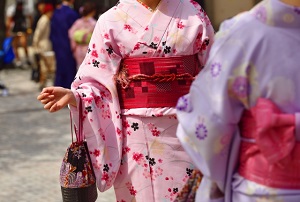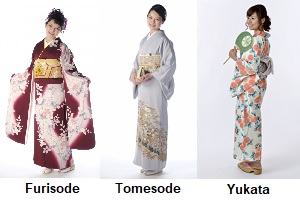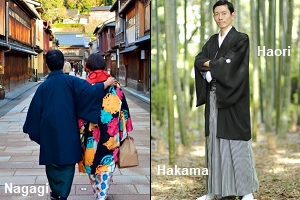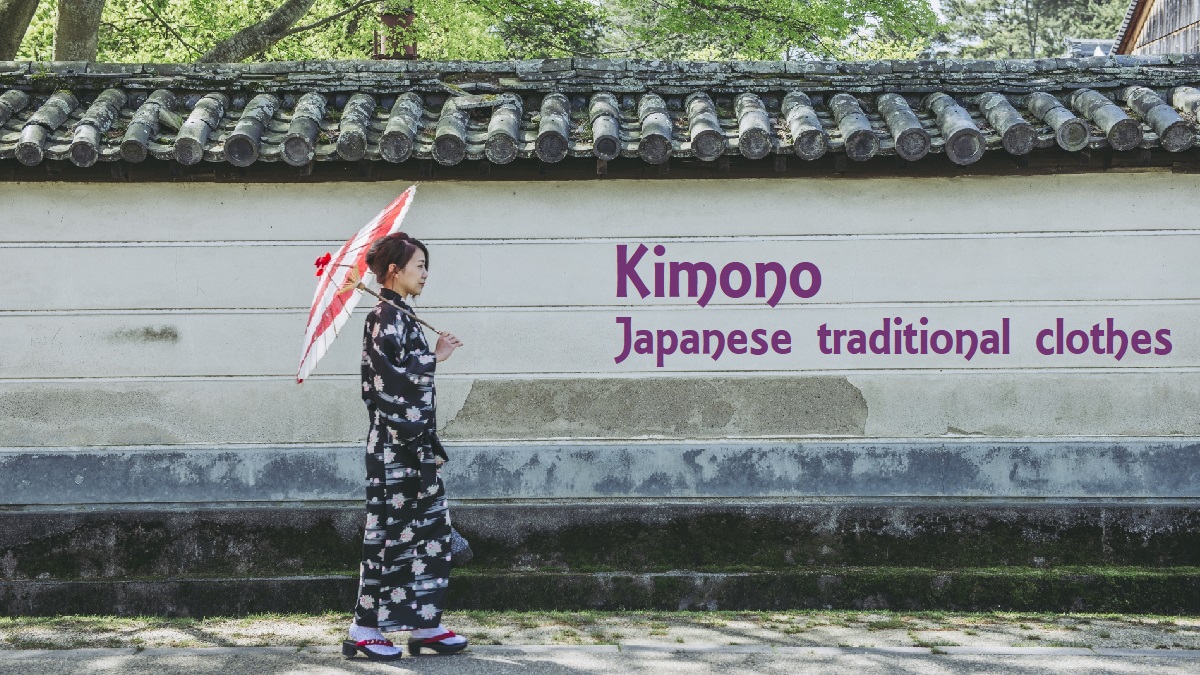About Kimono - Japanese traditional clothes
Basics about kimono

Kimono and Obi
Kimono is a Japanese word meaning simply "clothes".
Samurai and rich people had worn high-class kimono made from silk, and the other poor people had worn kimono made from cotton and hemp until the modern times.
Most Japanese people of all classes had worn kimono as everyday clothes until the early 20th century.
After that, Japanese people gradually wore Western clothes.
Now, kimono became the clothes which the people wear mainly for the special day in the life.
Kimono is long clothes from neck to foot, and the form is similar to gown.
Because the underwear is worn, the outermost is mainly called "kimono".
They are fixed at the waist with obi which is the belt of cloth.
The sleeves of kimono are large, and they are like pouches.
Kimono and obi are basically made of silk.
They are produced by using various traditional methods of weaving and dyeing.
Various patterns such as flower, pretty animal, geometric design etc. are drawn, and it is like a Japanese traditional art when the kimono is worn.
So, the formal kimonos are very expensive.
Kimono for women is colorful and gorgeous.
It is the fashion that all Japanese women love.

Yukata for man and woman
On the other hand, kimono for men mainly has dark and chic colors.
No gorgeous pattern is drawn, and quiet pattern or stripe is used.
Of course, there are gorgeous and colorful kimono for men.
On some kimono, brave pictures of dragon, tiger, etc. are drawn.
But, the man wearing such kimono implicitly regards him to be a frivolous and unapproachable person.
The man wearing quiet kimono casually is very smart.
Kimono isn't sporty and how to wear is complicated.
Now, only around 20% of Japanese people can wear kimono by themselves.
And, only about half of the people can wear Yukata (Thin type of kimono) by themselves.
So, most people have kimono dresser in major hair salons and kimono rental shops wear favorite kimono.
Accessories of kimono
Obi is an important partner of kimono, so it is also expensive.
Combination of kimono and obi is the point of dressing up.
Obi is a wide and colorful long cloth.
It is put around the waist and the edges are tied artistically on the back.
That is the most difficult technique to wear kimono.

Tabi and Zori

Geta for women
When we wear the kimono, we put on a pair of "tabi" instead of socks and wear a pair of "zori" instead of shoes.
(Shoes never suit with kimono)
Tabi is Japanese short socks and the toes are separated into a part for a big toe and a part for the other four toes.
Zori is a traditional footwear and it's like sandal.
It has a flat sole and a clog thong.
(For clog thong, we must wear Tabi.)
As casual footwear, "geta" is used.
Geta is the wooden sandal.
The clog thongs are tied to a wooden base.
Two wooden supports are attached under the base, so geta clatters when you walk.
Variety of kimono for women

Furisode, Tomesode
Furisode
Furisode is the most beautiful and gorgeous kimono and has very long sleeves.
"Furi" means "wave", and "sode" means the sleeve.
Literally, it is the kimono that the girl want to wave the sleeves innocently.
The color is brilliant and Japanese pictures are drawn on whole clothes.
As the name suggests, Furisode is for unmarried young women.
And it includes immature image.
In general, it is worn until 30 years old at most.
If a middle-aged woman wears Furisode, she may be seen as a little strange woman.
Furisode is generally worn for formal social events such as coming-of-age ceremony (20 years old) or wedding ceremonies.
Maiko girls in Kyoto also wear Furisode.
Tomesode
Tomesode is the most formal kimono.
"Tome" means "fasten", and "sode" means the sleeve.
The style is calm and graceful.
So, in contrast with Furisode, Tomesode is the kimono for mature woman.
All adult women can wear it in all types of ceremony.
The sleeves are short and the color are elegant.
The pictures and patterns are only on the lower part of the kimono.
This is exactly the style for Japanese mature woman.
As special Tomesode, there is "Kurotomesode".
It is black Tomesode and some family crests are on the cloths.
Kurotomesode is for married women, and the relatives of the new couple wear it in the wedding ceremony.
Homongi

Homongi, Yukata
Homongi means visiting dress.
The type of kimono is similar to Tomesode.
But it is more casual than Tomesode and the color and pattern are gorgeous.
Both married and unmarried women can wear Homongi in all occasions.
When tourists wear kimono in rental shop, this type of kimono is probably selected.
Yukata
Yukata is the casual kimono for hot season.
Therefore, yukata is made of cotton, hemp or chemical fiber.
In most cases, a lot of same patterns are printed on the entire cloth.
So, it looks more casual and active.
Generally it is worn directly on the underwear, so it is also used as a nightwear.
Obi for yukata is thin and soft.
So, it is easier to wear yukata than genuine kimono.
When you stay in Japanese ryokan or hotel, you can probably wear prepared yukata.
It is a casual wear and a nightwear only in the hotel.
In summer, young women wear the colorful yukata when some summer events are held.
That is one of summer fashions.
When you wear the yukata, you usually put on zori or geta with bare feet.
For young women, modern sandals are also OK.
When tourists wear kimono in rental shop, this type of kimono is good in summer.
Variety of kimono for men

Kimono with Haori for men, Montsuki & Hakama
Nagagi
"Nagagi" is the word that the style of general kimono is identified and means "long clothes" simply.
The main wear of kimono is called "Nagagi", so the kimono for both men and women are in the category.
The form of Nagagi (Kimono) for men is almost same as one for women.
But, the difference is that the color is quiet and it has no colorful patten.
And, there is no special type like Furisode.
Obi for women is worn around the position below the chest, but obi for men is worn around the hipbone.
Obi for men is thinner than for women, and the method to tie is simple.
Haori and hakama
Haori is like a little long cardigan and is worn on kimono.
It is for protection against the cold, so it is worn from autumn to spring.
And it is also a formal Kimono.
Especially, black Haori with some family crests is called montsuki.
Hakama is like trousers and is also worn on kimono.
Montsuki and Hakama are generally worn for formal social events.
But many men today wear the Western formal suits in such events.
By the way, the style of Haori and Hakama was the formal clothing for samurai.
Yukata
There is yukata for men.
The clothing material is the same as yukata for women.
Like Nagagi, the color is quiet and it has no colorful patten.
Other types of kimono

Working priests wearing Samue
Samue
Samue is originally work clothes of Buddhist monk.
It is similar to Judo uniform and the color is generally quiet and dark.
It is two-piece kimono and Obi is unnecessary.
You can find it in any temple.
And the workers in Japanese restaurants, craftsmen of traditional craft, etc. wear Samue.
So women can wear Samue.

Members of festival wearing Happi
Happi
Happi is similar to Haori, but it is simple and short.
In English, it is often translated as "Happi coat" or "Happy coat".
For a traditional festival and event, the same Happi are prepared like uniform.
All members of the operation team wear them, and the team is united.
So, the large-sized characters and marks of the team are printed on the Happi.
Try to wear kimono in Japan
For foreign tourist, there are some studios to rent kimono in major old cities.
Asakusa of Tokyo and Kyoto are the popular.
If you want to wear kimono, please check the following studios with some languages.
Studios with some shops in main cities (Asakusa, Kyoto, etc.)
Asakusa in Tokyo
Kyoto
Yumeyakata Okamoto Hana Kanzashi Hanakomachi Tekuteku Kyoto
Kanazawa
Kirara Karen Kokoyui Tsubaki Akari


